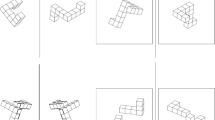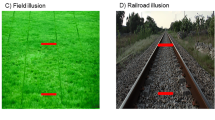Abstract
In this article we question the utility of the distinction between conceptual and nonconceptual content in cognitive science, and in particular, in the empirical study of visual perception. First, we individuate some difficulties in characterizing the notion of “concept” itself both in the philosophy of mind and cognitive science. Then we stress the heterogeneous nature of the notion of nonconceptual content and outline the complex and ambiguous relations that exist between the conceptual/nonconceptual duality and other pairs of notions, such as top–down/bottom-up and modular/nonmodular. Finally we look in greater detail at the proposal developed by Jacob and Jeannerod (Ways of seeing. The scopes and limits of visual cognition. Oxford, UK: Oxford University Press, 2003), who apply the notion of nonconceptual content to empirical research on visual perception. After reconstructing their point of view on concepts, we try to reject their major arguments in support of the conceptual/nonconceptual distinction, i.e. the compositionality of thought and the fineness of grain of percepts.
Similar content being viewed by others
Notes
Things are made more complex by the fact that also within the two fields considered separately this notion is used in a heterogeneous way, as we shall see in the following of this section.
E. Spelke does not posit a sharp distinction between perceptual and conceptual knowledge, see e.g. Shutts and Spelke (2004).
It should be noted that, according to Bermudez (1995), all nonconceptual content would have compositional structure, even if in a rather generic sense: “representational states must be structured so that they can be decomposed into their constituent elements which can then be recombined with the constituent elements of other representational states” (in Gunther 2003, p. 199).
References
Barsalou, L. W. (1985). Continuity of the conceptual system across species. Trends in Cognitive Sciences, 9(7), 305–311.
Bermudez, J. L. (1995). Nonconceptual content: From perceptual experience to subpersonal computational states. Mind and Language, 10, 333–369. [Reprinted in Gunther (2003)].
Bermudez, J. L. (2008). Nonconceptual mental content. Stanford Encyclopaedia of Philosophy, http://plato.stanford.edu/.
Biederman, I. (1995). Visual object recognition. In D. Oscherson (Ed.), An invitation to cognitive science (pp. 121–165). Cambridge, MA: MIT.
Brandom, R. (1994). Making it explicit. Cambridge, MA: Harvard University Press.
Bullier, J. (2001a). Integrated model of visual processing. Brain Research. Brain Research Reviews, 36, 96–107. doi:10.1016/S0165-0173(01)00085-6.
Bullier, J. (2001b). Feedback connections and conscious vision. Trends in Cognitive Sciences, 5(9), 369–370. doi:10.1016/S1364-6613(00)01730-7.
Carruthers, P. (2002). Modularity, language, and the flexibility of thought. The Behavioral and Brain Sciences, 25(6), 705–719.
Clark, A. (1994). Connectionism and cognitive flexibility. In T. Dartnall (Ed.), Artificial intelligence and creativity (pp. 63–79), Dorderecht: Kluwer. [Reprinted in Gunther (2003)].
Cussins, A. (1990). The connectionist construction of concepts. In M. Boden (Ed.), The philosophy of artificial intelligence (pp. 380–400). Oxford: Oxford University Press. Partially reprinted in Gunther (2003).
Cussins, A. (2003). Postscript to the partial reprint of Cussins (1990). In Gunther (2003), (pp. 147–159).
Dehaene, S. (1997). The number sense: How the mind creates mathematics. Oxford, UK: Oxford University Press.
Dennett, D. (1991). Consciousness explained. London: Penguin.
Dennett, D. (1994). Get real. Philosophical Topics, 22, 505–568.
Dennett, D. (1996). Seeing is believing–or is it? In K. Akins (Ed.), Perception (pp. 158–172). Oxford, UK: Oxford University Press.
Dennett, D. (2005). Sweet dreams. Cambridge, MA: MIT.
Dretske, F. (1969). Seeing and knowing. Chicago: Chicago University Press.
Dretske, F. (1981). Knowledge and the flow of information. Cambridge, MA: MIT.
Dretske, F. (1995). Naturalising the mind. Cambridge, MA: MIT.
Evans, G. (1982). The varieties of reference. Oxford, UK: Oxford University Press.
Fodor, J. (1998). Concepts. Where cognitive science went wrong. Oxford, UK: Clarendon.
Fodor, J. (2003). Hume variations. Oxford, UK: Oxford University Press.
Frixione, M. (2007). Do concepts exist? A naturalistic point of view. In C. Penco, M. Beaney, & M. Vignolo (Eds.), Explaining the mental. Cambridge, UK: Cambridge Scholars Publishing.
Gunther, Y. H. (Ed.). (2003). Essays on nonconceptual content. Cambridge, MA: MIT.
Jacob, P., & Jeannerod, M. (2003). Ways of seeing. The scopes and limits of visual cognition. Oxford, UK: Oxford University Press.
Kosslyn, S. M., Pascual-Leone, A., Felician, O., Camposano, S., Keenan, J. P., Thompson, W. L., et al. (1999). The role of area 17 in visual imagery: convergent evidence from PET and rTMS. Science, 284(5411), 167–170. doi:10.1126/science.284.5411.167.
Kosslyn, S. M., Thompson, W. L., & Ganis, G. (2006). The case for mental imagery. Oxford, UK: Oxford University Press.
Machery, E. (2005). Concepts are not a natural kind. Philosophy of Science, 72, 444–467. doi:10.1086/498473.
Machery, E. (2009). Doing without concepts. Oxford, UK: Oxford University Press.
Marr, D. (1982). Vision: A computational investigation into the human representation and processing of visual information. New York, NY: Freeman.
McDowell, J. (1994). Mind and world. Cambridge, MA: Harvard University Press.
Milner, D. A., & Goodale, M. A. (1995). The visual brain in action. Oxford, UK: Oxford University Press.
Murphy, G. L. (2002). The big book of concepts. Cambridge, MA: MIT.
Noe, A. (2004). Action in perception. Cambridge, MA: MIT.
O’Regan, K., & Noe, A. (2001). A sensorimotor account of vision and visual consciousness. The Behavioral and Brain Sciences, 24, 939–1011.
Peacocke, C. (1992). A study of concepts. Cambridge, MA: MIT.
Prinz, J., & Clark, A. (2004). Putting concepts to work: Some thoughts for the 21st century (a reply to Fodor). Mind & Language, 19(1), 57–69. doi:10.1111/j.1468-0017.2004.00247.x.
Raftopoulos, A., & Müller, V. (2006). The nonconceptual content of experience. Mind & Language, 27(2), 187–219. doi:10.1111/j.0268-1064.2006.00311.x.
Rizzolatti, G., & Gallese, V. (1997). From action to meaning. In J.-L. Petit (Ed.), Les Neurosciences et la Philosophie de l’Action. Paris: Librairie Philosophique J. Vrin.
Rizzolatti, G., Sinigaglia, C., & Anderson, F. (2007). Mirrors in the brain: How our minds share actions, emotions, and experience. Oxford, UK: Oxford University Press.
Shutts, K., & Spelke, E. S. (2004). Straddling the perception-conception boundary. Developmental Science, 7, 507–511. doi:10.1111/j.1467-7687.2004.00371.x.
Spelke, E. S. (1994). Initial knowledge: Six suggestions. Cognition, 50, 431–445. doi:10.1016/0010-0277(94)90039-6.
Spelke, E. S., & Kinzler, K. D. (2007). Core knowledge. Developmental Science, 10(1), 89–96. doi:10.1111/j.1467-7687.2007.00569.x.
Thompson, E. (1995). Colour vision. London, UK: Routledge Press.
Tye, M. (2006). Nonconceptual content, richness, and fineness of grain. In T. Szabo-Gendler & J. Hawthorne (Eds.), Perceptual experience. Oxford, UK: Oxford University Press.
Acknowledgements
We would like to thank Marco Mazzone, Carlo Penco, Pietro Perconti and Alessio Plebe for reading earlier versions of this paper and for discussing the theses presented in it.
Author information
Authors and Affiliations
Corresponding author
Rights and permissions
About this article
Cite this article
Dell’Anna, A., Frixione, M. On the Advantage (If Any) and Disadvantage of the Conceptual/Nonconceptual Distinction for Cognitive Science. Minds & Machines 20, 29–45 (2010). https://doi.org/10.1007/s11023-010-9182-2
Received:
Accepted:
Published:
Issue Date:
DOI: https://doi.org/10.1007/s11023-010-9182-2




